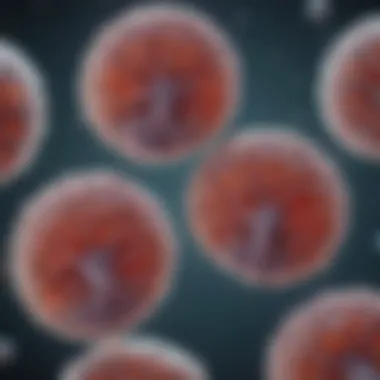Innovative Approaches to Glioblastoma Research at UCSF


Intro
Glioblastoma remains one of the most aggressive forms of brain tumor, posing significant challenges for researchers and clinicians alike. At the University of California, San Francisco, ongoing research initiatives reflect a commitment to understanding and combating this formidable disease. The multifaceted nature of glioblastoma demands wide-ranging approaches, and UCSF has become a leader in both treatment and research.
This article will delve into the extensive endeavors undertaken by UCSF to explore glioblastoma. We will address key findings from recent studies, the methodologies employed in research, as well as the historical context that has shaped current trends in the field. The aim is to provide a comprehensive overview that highlights the complexities of glioblastoma, while also illustrating the potential avenues for future breakthroughs.
Research Overview
Key Findings
Significant advancements have been made in understanding the molecular biology of glioblastoma. Studies conducted at UCSF emphasize the heterogeneity of tumor cells. This heterogeneity influences treatment responses and patient outcomes.
Recent findings from UCSF highlight:
- The importance of personalized medicine in treatment plans.
- The role of immunotherapy in enhancing patient survival rates.
- The potential of utilizing novel drug combinations to improve efficacy.
Study Methodology
To investigate the complexities of glioblastoma, UCSF employs diverse methodologies. This includes the use of preclinical models, clinical trials, and advanced imaging techniques. Researchers prioritize a collaborative approach across disciplines, integrating insights from neurology, pathology, and molecular biology.
Key components of their methodology include:
- Comprehensive genomic profiling to identify mutations.
- Patient-derived xenografts for studying tumor behavior.
- Data analysis using bioinformatics to correlate genetic information with treatment outcomes.
Background and Context
Historical Background
Understanding glioblastoma requires an appreciation of its historical context. Glioblastoma has been documented since the late 19th century, but it is the last few decades that have seen a surge in research. The World Health Organization updated classification systems to better categorize this aggressive tumor, leading to more targeted studies.
Current Trends in the Field
Present-day research is increasingly focused on tailoring therapies to individual patients. The shift towards precision medicine is at the forefront of efforts at UCSF. There is also a growing interest in exploring combination therapies that leverage multiple treatment modalities to enhance effectiveness.
"With glioblastoma, a one-size-fits-all approach is insufficient. Tailored strategies provide new hope for patients."
Research initiatives continue to evolve, with UCSF at the helm. Keeping abreast of breakthroughs is crucial for both academics and clinicians in their pursuit of effective treatments.
Preface to Glioblastoma
Understanding glioblastoma is crucial to grasping the broader implications of brain cancers and their treatment. Glioblastoma is among the most aggressive types of brain tumors, characterized by rapid growth and poor prognosis. This section outlines key elements that shape our understanding of glioblastoma, including its definition and prevalence. By delineating these factors, we lay a necessary foundation for further exploration of clinical manifestations, research efforts at UCSF, and emerging therapeutic strategies.
Defining Glioblastoma
Glioblastoma, classified as a grade IV astrocytoma, originates from glial cells, which support and protect neurons in the brain. Its hallmark features include a highly infiltrative growth pattern and cellular heterogeneity, making it difficult to treat. The tumor presents predominantly in adults and often arises in the cerebral hemispheres. Clinicians categorize glioblastoma into primary and secondary types, with primary glioblastoma occurring de novo while secondary develops from lower-grade gliomas. Modeling the complexities of glioblastoma reveals not merely a tumor but a multifaceted disease characterized by diverse genetic alterations and environmental influences.
Epidemiology and Demographics
Glioblastoma has a distinct demographic profile. It typically affects adults between the ages of 45 and 70, with a slightly higher incidence in men compared to women. According to data, glioblastoma accounts for roughly 15% of all brain tumors and about 50% of all malignant brain tumors. Patients who are Caucasian appear to have a higher incidence rate than those from other ethnic backgrounds. However, survival rates remain consistently low across demographics, with a median survival time of approximately 15 months post-diagnosis. The examination of epidemiological data highlights important considerations for targeted research and treatment approaches, as variations in incidence and outcomes could inform both clinical and laboratory studies.
Understanding the demographic nuances related to glioblastoma can enhance the focus of research efforts, leading to more effective treatment modalities.
By establishing what glioblastoma is, and identifying who it predominantly affects, we can better navigate the complexities involved in its research and treatment. This understanding is paramount as we delve into the clinical manifestations, the pivotal role of institutions like UCSF in advancing research, and the development of innovative therapies.
Clinical Manifestations
Understanding clinical manifestations of glioblastoma is crucial for both diagnosis and treatment planning. These manifestations encompass a range of symptoms that result from the presence of the tumor in the brain. Recognizing these symptoms early can significantly affect the timeliness of intervention, which is pivotal given glioblastoma's aggressive nature. Clinicians and researchers at UCSF pay close attention to how these manifestations present, as they play a central role in guiding therapeutic decisions.


Symptoms and Diagnosis
Glioblastoma presents with a variety of symptoms that can fluctuate based on tumor location and growth rate. Common symptoms include:
- Headaches: Often persistent and can worsen over time.
- Seizures: New onset seizures are particularly concerning.
- Cognitive Changes: Patients may experience memory issues, confusion, or difficulty in decision-making.
- Motor Weakness: This can manifest as weakness in the limbs or difficulty with coordination.
- Changes in Vision: Blurred or double vision can occur depending on the tumor's location.
Diagnosis involves a multidisciplinary approach. Physicians typically start with a thorough patient history and physical examination, followed by neurological assessments. The American Academy of Neurology guidelines and recommendations are consulted. These steps help in forming an initial understanding of the patient’s condition. If glioblastoma is suspected, imaging techniques, particularly MRI, are necessary.
Imaging Techniques in Diagnosing Glioblastoma
Imaging plays a pivotal role in the identification and characterization of glioblastoma. Several techniques are employed at UCSF to facilitate accurate diagnosis:
- Magnetic Resonance Imaging (MRI): This is the gold standard for brain imaging due to its high-resolution capabilities. It allows for the detailed examination of brain structures and tumor morphology.
- Functional MRI (fMRI): This provides information about brain activity, helping to map important functional areas before surgery.
- Computed Tomography (CT) Scans: While less detailed than MRI, CT scans can be useful in emergency settings to quickly assess the brain's condition.
- Positron Emission Tomography (PET) Scans: These are employed less frequently but can offer insights into metabolic activity of the tumor, aiding in differential diagnosis.
The integration of these imaging modalities is essential not just for diagnosis, but also for treatment planning and monitoring post-therapy changes.
"Accurate imaging is fundamentally important to devise an effective treatment strategy against glioblastoma."
UCSF's Role in Glioblastoma Research
UCSF has established itself as a pioneering institution in glioblastoma research. It plays a critical role in both basic and clinical research that advances understanding and treatment of this aggressive brain tumor. The integration of various disciplines at UCSF enables innovative approaches in tackling glioblastoma. The researchers and clinicians work collaboratively to find better diagnostic methods and treatment options, impacting patient care significantly.
Historical Perspective
The history of glioblastoma research at UCSF is marked by significant milestones. From the early recognition of the tumor's aggressive nature to advancements in surgical techniques, each decade has brought important changes. The establishment of specialized neurosurgical units helped streamline treatment approaches, utilizing cutting-edge imaging technologies and surgical expertise.
UCSF has also been involved in pivotal clinical trials. These trials have aimed to evaluate new drugs, treatment combinations, and supportive therapies. The findings from these studies not only contribute to the academic knowledge but also have direct implications for patient outcomes. Over time, a culture of innovation has emerged. This culture encourages experimentation and has led to breakthroughs that shape the current understanding of glioblastoma.
Current Initiatives and Research Programs
Currently, UCSF is at the forefront of several initiatives targeting glioblastoma. Researchers are focusing on diverse aspects of treatment, including:
- Tumor Biology: Understanding the genetic and molecular profile of glioblastoma tumors to identify potential targets for therapy.
- Immunotherapy: Developing treatments that harness the body's immune system to combat cancer cells more effectively.
- Clinical Trials: Running multiple trials that offer patients access to promising new therapies before they are widely available.
- Collaborations: Partnering with other institutions and organizations to expand research efforts and share findings.
These initiatives not only aim to enhance survival rates but also focus on improving quality of life for patients. Researchers at UCSF are utilizing advanced technologies, such as precision medicine and personalized treatment plans, to develop more effective strategies to combat this challenging disease.
"UCSF's commitment to glioblastoma research showcases the integration of cutting-edge science and clinical expertise, ultimately aiming for breakthroughs that can improve the future of treatment."
Each of these elements illustrates how UCSF continues to lead the charge in glioblastoma research, influencing both the scientific community and impacting patients' lives.
Treatment Modalities
Treatment modalities for glioblastoma encompass various strategies designed to manage this aggressive brain tumor. The significance of understanding these modalities lies in their potential to improve patient outcomes, extend survival rates, and enhance the overall quality of life. Each approach carries its unique considerations, risks, and expected benefits, thus requiring thorough examination and understanding.
Surgical Approaches
Surgery often represents the first line of defense against glioblastoma. The main goal of surgery is to resect as much of the tumor as possible while preserving surrounding healthy tissue. It is not always feasible to remove the entire tumor due to its infiltrative nature. Neurosurgeons use advanced imaging techniques, such as intraoperative MRI, to guide the surgical process.
Benefits of Surgical Approaches:
- Maximal Tumor Removal: Maximizing resection often correlates with improved survival rates.
- Symptom Relief: Surgery can alleviate symptoms caused by increased intracranial pressure or mass effect.
- Diagnosis Confirmation: Tissue obtained during surgery aids in confirming the diagnosis and may provide insights into tumor characteristics.
Considerations:
- Risks: Complications from surgery can include infection, bleeding, and neurological deficits.
- Extent of Resection: The precise balance between safe resection and preservation of brain function is critical and difficult to achieve in many cases.
Radiation Therapy


Radiation therapy plays a critical role in the treatment protocol for glioblastoma, often utilized post-surgery to target residual tumor cells. The therapy uses high-energy waves to damage the DNA of cancer cells, inhibiting their ability to proliferate.
Benefits of Radiation Therapy:
- Targeted Treatment: Focuses on areas exposed to tumor cells while minimizing damage to surrounding healthy tissues.
- Standard care: Current guidelines recommend radiation as part of standard treatment after surgery for glioblastoma patients.
- Efficacy: Studies show that adjuvant radiation therapy significantly improve overall survival rates.
Considerations:
- Side Effects: Patients may experience fatigue, skin irritation, and long-term cognitive effects.
- Technological Advances: Techniques such as stereotactic radiosurgery have enhanced the precision of treatment plans.
Chemotherapy Protocols
Chemotherapy complements surgery and radiation therapy as a systemic approach to glioblastoma treatment. Temozolomide is the most commonly used chemotherapy agent, often given in conjunction with radiation therapy.
Benefits of Chemotherapy Protocols:
- Systemic Treatment: Chemotherapy addresses tumor cells that may have spread beyond the primary site, providing a comprehensive treatment strategy.
- Genetic Profiling: Understanding the patient's tumor genetics can help tailor chemotherapy regimens, optimizing therapeutic efficacy.
Considerations:
- Side Effects: Chemotherapy can lead to nausea, vomiting, and immunosuppression, complicating the overall treatment process.
- Resistance: Some patients may develop resistance to chemotherapy agents, posing challenges in management.
In summary, treatment modalities for glioblastoma involve a multifaceted approach, integrating surgical intervention, radiation, and chemotherapy. Understanding the benefits and limitations of each modality is essential for optimizing patient care and advancing outcomes.
Innovative Treatments and Research
The landscape of glioblastoma treatment has evolved significantly, and innovative research plays a crucial role in this progress. The critical nature of glioblastoma, marked by its aggressive behavior and poor prognosis, necessitates a relentless pursuit of new therapies. At UCSF, researchers and clinicians focus on a range of innovative treatments that seek to enhance patients’ outcomes and quality of life. By exploring new methodologies, from immunotherapy to nanotechnology, this research pipeline aims to overcome the many hurdles presented by traditional therapies.
Immunotherapy Developments
Immunotherapy represents a paradigm shift in cancer treatment, engaging the body's immune system to identify and attack tumor cells. UCSF’s work in this field emphasizes the development of therapies that can enhance immune responses. Certain strategies include checkpoint inhibitors and CAR-T cell therapy.
- Checkpoint Inhibitors: These agents work by blocking proteins that prevent immune cells from attacking cancer. Studies at UCSF investigate the efficacy of these inhibitors specifically for glioblastoma.
- CAR-T Cell Therapy: This approach involves modifying a patient's T cells to better recognize and target tumor antigens unique to glioblastoma cells. Preliminary trials at UCSF show promise, though challenges remain in ensuring long-lasting immune responses.
The incorporation of immunotherapy not only aims at increasing survival rates but also possibly redefining the standard of care.
Targeted Therapies and Molecular Approaches
Targeted therapies focus on specific molecular alterations within glioblastoma cells. These treatments are designed to attack cancer cells while sparing normal cells, leading to potentially fewer side effects. At UCSF, researchers are uncovering valuable insights into the genetic and molecular characteristics of glioblastoma, allowing for the development of interventions that fit individual patient profiles.
Key areas of focus include:
- EGFR Inhibitors: Abnormalities in the epidermal growth factor receptor are common in glioblastoma and targeted inhibitors are under investigation.
- ID Inhibitors: Mutations in the isocitrate dehydrogenase 1 gene also represent a new target for therapy. UCSF researchers are actively studying the implications of these mutations in treatment outcomes.
These approaches not only enhance the precision of therapy but also aim to mitigate the tumor’s ability to resist conventional treatments.
Nanotechnology in Glioblastoma Treatment
Nanotechnology involves manipulating materials at a molecular or atomic scale. In glioblastoma research, this technology holds extensive promise in drug delivery and diagnostics. At UCSF, ongoing projects explore using nanoparticles to improve the delivery of therapeutic agents directly to tumor sites.
Factors such as:
- Increased Drug Solubility: Nanoparticles can improve the solubility of poorly soluble drugs, enhancing their therapeutic potential.
- Targeted Delivery: This technology allows for a more precise delivery of drugs, minimizing damage to healthy tissues.
- Enhanced Imaging Techniques: Nanoparticles can also be used as contrast agents in imaging techniques, aiding in real-time visualization of tumors during treatment.
The research in this area is burgeoning, and as studies progress, novel applications of nanotechnology may revolutionize how glioblastoma is treated.
Innovative research at UCSF not only fosters hope for patients but also lays a foundation for future advancements in glioblastoma treatment.


Challenges in Research and Treatment
Understanding the challenges in glioblastoma research and treatment is crucial for uncovering ways to improve patient outcomes. The multifaceted nature of this disease presents significant barriers that scientists and clinicians must overcome. Heterogeneity of tumors is an intrinsic problem. Each glioblastoma is unique, influencing its response to treatment. This variation can make it difficult to develop standardized treatment protocols.
Another primary challenge relates to clinical trials and patient recruitment. Finding enough suitable candidates for trials can be a slow process. Often, potential participants face barriers such as health conditions, distance to treatment centers, or personal circumstances that prevent their involvement.
Heterogeneity of Tumors
The heterogeneity of tumors refers to the differences in genetic, cellular, and molecular characteristics within and between tumors. In glioblastoma patients, this heterogeneity means that one tumor may respond well to a specific chemotherapy, while another might not. This variance complicates the development of effective treatment strategies. As researchers at UCSF delve deeper into the genetic and molecular profiles of glioblastoma, they shift towards personalized medicine approaches. This strategy involves tailoring treatment based on the individual tumor characteristics rather than applying a one-size-fits-all treatment model.
This unique approach has the potential to improve therapeutic effectiveness but also raises questions about accessibility and cost. With diverse tumor profiles, trials must be designed to accommodate multiple treatment regimens, making them more complex and time-consuming.
Clinical Trials and Patient Recruitment Issues
Clinical trials play a vital role in the advancement of glioblastoma treatment. They test new therapies and assess their efficacy and safety. However, patient recruitment for these trials poses its own set of challenges. Many patients are reluctant to participate in trials due to fear of the uncertain outcomes or potential side effects of experimental treatments.
Moreover, patients often have limited awareness of ongoing trials. This issue highlights the need for improved communication between research institutions and the public. Efforts to increase awareness can include community outreach and partnerships with patient advocacy groups.
Another consideration is the geographic distribution of clinical trial sites. Often, these sites are concentrated in urban areas, making access difficult for patients in rural locations.
"Addressing these recruitment challenges is critical to advancing research and ensuring diverse patient representation in clinical studies."
Overall, confronting the challenges in glioblastoma research and treatment is vital. Continuous efforts to address tumor heterogeneity and enhance clinical trial participation could provide the pathways necessary for meaningful advances in patient care.
Future Directions in Glioblastoma Research
Future directions in glioblastoma research are critical for advancing our understanding and improving treatments for this aggressive tumor. Continuous exploration is necessary to keep pace with its complex biology and to address the limitations of current treatment methods. As researchers at UCSF and globally strive to find effective strategies to combat glioblastoma, innovations and collaborative efforts will likely play a significant role in overcoming existing challenges. Each emerging trend in research brings with it the potential to enhance patient outcomes and reshape how glioblastoma is treated.
Emerging Trends and Technologies
Recent years have witnessed significant advancements in technology that enhance glioblastoma research. Techniques such as genomic sequencing are paving the way for personalized medicine approaches. The ability to analyze a tumor's genetic profile allows for tailored therapies that specifically target the mutations present within each patient's tumor.
Furthermore, advancements in imaging technologies are improving our ability to diagnose and monitor glioblastoma. For instance, techniques like functional MRI and PET scans are being refined to provide clearer insights into tumor behavior and treatment response. These methods not only enhance diagnostic accuracy but also aid in better understanding tumor dynamics, which can inform therapeutic decisions.
Other innovative trends include the exploration of artificial intelligence (AI) in predicting treatment responses and outcomes. AI algorithms process vast amounts of data, providing insights that might be overlooked by human analysis. This technology has potential to revolutionize clinical decision-making by aiding in precision medicine and optimizing patient management.
"The integration of novel technologies into glioblastoma research is vital for unlocking new pathways for treatment and improving prognosis for patients."
Interdisciplinary Approaches
Interdisciplinary approaches are essential in tackling glioblastoma due to its multifaceted nature. Collaboration between oncologists, neuroscientists, bioinformaticians, and pharmacologists can yield innovative strategies for glioblastoma management. For example, integrating insights from neuroscience can help understand the tumor's impact on brain function, while bioinformatics can reveal patterns in large datasets that drive new discoveries.
Collaborations also extend to institutions worldwide, facilitating large-scale clinical trials that can rapidly assess new therapies. Setting up networks of researchers allows for shared expertise and resources, ultimately leading to breakthroughs that individual labs might not achieve alone.
Furthermore, engaging with patients and advocating for their needs leads to more relevant and effective research outcomes. Understanding patient experiences can help refine research questions and treatment options, ensuring that they align with what is most important to those affected by glioblastoma.
In summary, keeping an eye on emerging trends and embracing interdisciplinary collaborations will be crucial as UCSF and the broader research community move towards future innovations in glioblastoma treatment. With continued dedication, the horizon for better patient outcomes appears promising.
Epilogue
In this article, we explored the complexities and advancements in glioblastoma research at UCSF. As one of the most challenging forms of brain cancer, glioblastoma presents a unique set of trials that necessitate a rigorous, multi-faceted research approach. Understanding the disease's intricacies allows researchers and clinicians to develop more effective treatment modalities. UCSF's commitment to innovative research earmarks it as a leader in this critical field, making significant contributions to the fight against glioblastoma.
Summary of Key Points
We have highlighted several essential aspects concerning glioblastoma research at UCSF:
- Defining Glioblastoma: Clear understanding of what glioblastoma is, including its aggressive nature.
- Historical Perspective: UCSF’s long-standing involvement and leadership in glioblastoma research.
- Treatment Modalities: Overview of various treatment options such as surgery, radiation therapy, and chemotherapy protocols.
- Innovative Treatments: Insight into emerging therapies like immunotherapy and targeted treatments.
- Challenges in Treatment: Discussion of tumor heterogeneity and clinical trial recruitment hurdles.
- Future Directions: Emerging trends, technologies, and interdisciplinary strategies that hold promise.
Call for Collaborative Research Efforts
The battle against glioblastoma requires a collaborative effort among researchers, healthcare professionals, and institutions. By leveraging shared insights and resources, the scientific community can address the multifaceted challenges posed by this disease. \n
- Interdisciplinary Collaboration: Communicating across various fields like biology, technology, and medicine will foster innovation.
- Patient Involvement: Engaging patients in research initiatives can provide valuable perspectives and improve recruitment for clinical trials.
- Funding and Resources: Increased investment in glioblastoma research can facilitate the development of new therapies.







